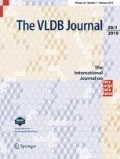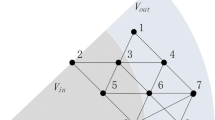Abstract
Social contagion depicts a process of information (e.g., fads, opinions, news) diffusion in the online social networks. A recent study reports that in a social contagion process, the probability of contagion is tightly controlled by the number of connected components in an individual’s neighborhood. Such a number is termed structural diversity of an individual, and it is shown to be a key predictor in the social contagion process. Based on this, a fundamental issue in a social network is to find top-\(k\) users with the highest structural diversities. In this paper, we, for the first time, study the top-\(k\) structural diversity search problem in a large network. Specifically, we study two types of structural diversity measures, namely, component-based structural diversity measure and core-based structural diversity measure. For component-based structural diversity, we develop an effective upper bound of structural diversity for pruning the search space. The upper bound can be incrementally refined in the search process. Based on such upper bound, we propose an efficient framework for top-\(k\) structural diversity search. To further speed up the structural diversity evaluation in the search process, several carefully devised search strategies are proposed. We also design efficient techniques to handle frequent updates in dynamic networks and maintain the top-\(k\) results. We further show how the techniques proposed in component-based structural diversity measure can be extended to handle the core-based structural diversity measure. Extensive experimental studies are conducted in real-world large networks and synthetic graphs, and the results demonstrate the efficiency and effectiveness of the proposed methods.




















Similar content being viewed by others
References
Agrawal, R., Gollapudi, S., Halverson, A., Ieong, S.: Diversifying search results. In: WSDM, pp. 5–14 (2009)
Angel, A., Koudas, N.: Efficient diversity-aware search. In: SIGMOD, pp. 781–792 (2011)
Backstrom, L., Huttenlocher, D.P., Kleinberg, J.M., Lan, X.: Group formation in large social networks: membership, growth, and evolution. In: KDD, pp. 44–54 (2006)
Batagelj, V., Zaversnik, M.: An o (m) algorithm for cores decomposition of networks (2003). arXiv preprint cs/0310049
Chang, K., Hwang, S.: Minimal probing: supporting expensive predicates for top-k queries. In: SIGMOD, pp. 346–357 (2002)
Cheng, J., Ke, Y., Chu, S., Özsu, M.T.: Efficient core decomposition in massive networks. In: ICDE, pp. 51–62 (2011)
Chiba, N., Nishizeki, T.: Arboricity and subgraph listing algorithms. SIAM J. Comput. 14(1), 210–223 (1985)
Chu, S., Cheng, J.: Triangle listing in massive networks and its applications. In: KDD, pp. 672–680 (2011)
Cormen, T.H., Leiserson, C.E., Rivest, R.L., Stein, C.: Introduction to Algorithms. MIT Press, Cambridge (2009)
Dodds, P.S., Watts, D.J.: Universal behavior in a generalized model of contagion. Phys. Rev. Lett. 92, 218701 (2004)
Dorogovtsev, S.N., Mendes, J.F.F., Samukhin, A.N.: Structure of growing networks with preferential linking. Phys. Rev. Lett. 85(21), 4633 (2000)
Fagin, R.: Combining fuzzy information from multiple systems. J. Comput. Syst. Sci. 58(1), 83–99 (1999)
Fagin, R., Lotem, A., Naor, M.: Optimal aggregation algorithms for middleware. In: PODS, pp. 102–113 (2001)
Huang, X., Cheng, H., Li, R.-H., Qin, L., Yu, J.X.: Top-k structural diversity search in large networks. PVLDB 6(13), 1618–1629 (2013)
Ilyas, I., Beskales, G., Soliman, M.: A survey of top-k query processing techniques in relational database systems. ACM Comput. Surv. (CSUR) 40(4), 11 (2008)
Itai, A., Rodeh, M.: Finding a minimum circuit in a graph. SIAM J. Comput. 7(4), 413–423 (1978)
Kwak, H., Lee, C., Park, H., Moon, S.B.: What is twitter, a social network or a news media? In: WWW, pp. 591–600 (2010)
Latapy, M.: Main-memory triangle computations for very large (sparse (power-law)) graphs. Theor. Comput. Sci. 407(1–3), 458–473 (2008)
Li, R.-H., Yu, J.X.: Scalable diversified ranking on large graphs. In: ICDM, pp. 1152–1157 (2011)
Luo, Y., Lin, X., Wang, W., Zhou, X.: Spark: top-k keyword query in relational databases. In: SIGMOD, pp. 115–126 (2007)
Qin, L., Yu, J.X., Chang, L.: Diversifying top-k results. PVLDB 5(11), 1124–1135 (2012)
Romero, D.M., Meeder, B., Kleinberg, J.M.: Differences in the mechanics of information diffusion across topics: idioms, political hashtags, and complex contagion on twitter. In: WWW, pp. 695–704 (2011)
Schank, T.: Algorithmic aspects of triangle-based network analysis. Ph.D. Dissertation, University Karlsruhe (2007)
Schank, T., Wagner, D.: Finding, counting and listing all triangles in large graphs, an experimental study. In: WEA, pp. 606–609 (2005)
Ugander, J., Backstrom, L., Marlow, C., Kleinberg, J.: Structural diversity in social contagion. Proc. Natl. Acad. Sci. 109(16), 5962–5966 (2012)
Watts, D.J., Dodds, P.S.: Influentials, networks, and public opinion formation. J. Consum. Res. 34, 441–458 (2007)
Xiao, C., Wang, W., Lin, X., Shang, H.: Top-k set similarity joins. In: ICDE, pp. 916–927 (2009)
Zhang, Y., Callan, J., Minka, T.: Novelty and redundancy detection in adaptive filtering. In: SIGIR, pp. 81–88 (2002)
Zhu, X., Guo, J., Cheng, X., Du, P., Shen, H.: A unified framework for recommending diverse and relevant queries. In: WWW, pp. 37–46 (2011)
Acknowledgments
This work is supported by the Hong Kong Research Grants Council (RGC) General Research Fund (GRF) Project Nos. CUHK 411211, 418512, 14209314, the Chinese University of Hong Kong Direct Grant Nos. 4055015, 4055048, NSFC Grants No. 61402292, and Natural Science Foundation of SZU Grant No. 201438. Lu Qin is supported by ARC DE140100999.
Author information
Authors and Affiliations
Corresponding author
Rights and permissions
About this article
Cite this article
Huang, X., Cheng, H., Li, RH. et al. Top-K structural diversity search in large networks. The VLDB Journal 24, 319–343 (2015). https://doi.org/10.1007/s00778-015-0379-0
Received:
Revised:
Accepted:
Published:
Issue Date:
DOI: https://doi.org/10.1007/s00778-015-0379-0




